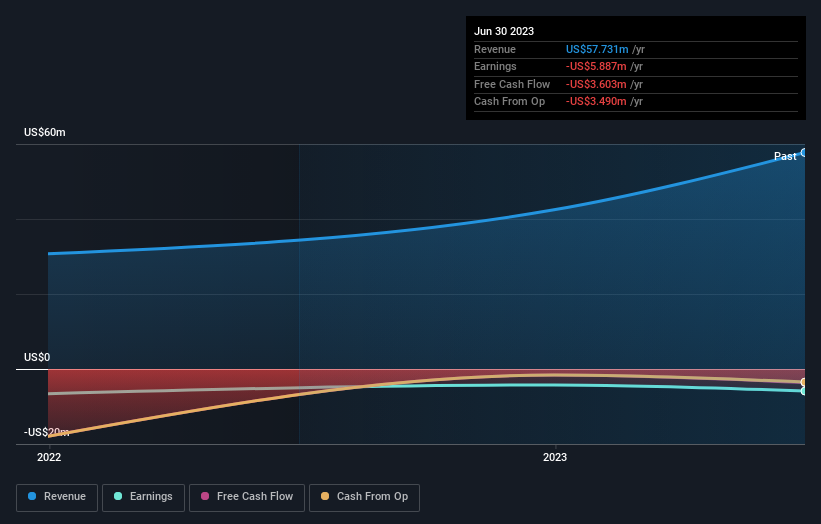Stock Analysis
- United States
- /
- Diversified Financial
- /
- NasdaqCM:FAAS
Individual investors invested in DigiAsia Corp. (NASDAQ:FAAS) copped the brunt of last week's US$56m market cap decline

Key Insights
- DigiAsia's significant individual investors ownership suggests that the key decisions are influenced by shareholders from the larger public
- The top 9 shareholders own 49% of the company
- 49% of DigiAsia is held by insiders
A look at the shareholders of DigiAsia Corp. (NASDAQ:FAAS) can tell us which group is most powerful. The group holding the most number of shares in the company, around 51% to be precise, is individual investors. Put another way, the group faces the maximum upside potential (or downside risk).
While insiders who own 49% came under pressure after market cap dropped to US$415m last week,individual investors took the most losses.
In the chart below, we zoom in on the different ownership groups of DigiAsia.
View our latest analysis for DigiAsia

What Does The Lack Of Institutional Ownership Tell Us About DigiAsia?
Institutional investors often avoid companies that are too small, too illiquid or too risky for their tastes. But it's unusual to see larger companies without any institutional investors.
There are multiple explanations for why institutions don't own a stock. The most common is that the company is too small relative to funds under management, so the institution does not bother to look closely at the company. It is also possible that fund managers don't own the stock because they aren't convinced it will perform well. DigiAsia might not have the sort of past performance institutions are looking for, or perhaps they simply have not studied the business closely.

We note that hedge funds don't have a meaningful investment in DigiAsia. The company's largest shareholder is Alexander Rusli, with ownership of 13%. Meanwhile, the second and third largest shareholders, hold 12% and 8.1%, of the shares outstanding, respectively.
A deeper look at our ownership data shows that the top 9 shareholders collectively hold less than half of the register, suggesting a large group of small holders where no single shareholder has a majority.
While studying institutional ownership for a company can add value to your research, it is also a good practice to research analyst recommendations to get a deeper understand of a stock's expected performance. Our information suggests that there isn't any analyst coverage of the stock, so it is probably little known.
Insider Ownership Of DigiAsia
The definition of an insider can differ slightly between different countries, but members of the board of directors always count. Company management run the business, but the CEO will answer to the board, even if he or she is a member of it.
Insider ownership is positive when it signals leadership are thinking like the true owners of the company. However, high insider ownership can also give immense power to a small group within the company. This can be negative in some circumstances.
It seems insiders own a significant proportion of DigiAsia Corp.. Insiders own US$201m worth of shares in the US$415m company. It is great to see insiders so invested in the business. It might be worth checking if those insiders have been buying recently.
General Public Ownership
The general public -- including retail investors -- own 51% of DigiAsia. With this amount of ownership, retail investors can collectively play a role in decisions that affect shareholder returns, such as dividend policies and the appointment of directors. They can also exercise the power to vote on acquisitions or mergers that may not improve profitability.
Next Steps:
While it is well worth considering the different groups that own a company, there are other factors that are even more important. Case in point: We've spotted 1 warning sign for DigiAsia you should be aware of.
Of course this may not be the best stock to buy. Therefore, you may wish to see our free collection of interesting prospects boasting favorable financials.
NB: Figures in this article are calculated using data from the last twelve months, which refer to the 12-month period ending on the last date of the month the financial statement is dated. This may not be consistent with full year annual report figures.
Valuation is complex, but we're helping make it simple.
Find out whether DigiAsia is potentially over or undervalued by checking out our comprehensive analysis, which includes fair value estimates, risks and warnings, dividends, insider transactions and financial health.
View the Free AnalysisHave feedback on this article? Concerned about the content? Get in touch with us directly. Alternatively, email editorial-team (at) simplywallst.com.
This article by Simply Wall St is general in nature. We provide commentary based on historical data and analyst forecasts only using an unbiased methodology and our articles are not intended to be financial advice. It does not constitute a recommendation to buy or sell any stock, and does not take account of your objectives, or your financial situation. We aim to bring you long-term focused analysis driven by fundamental data. Note that our analysis may not factor in the latest price-sensitive company announcements or qualitative material. Simply Wall St has no position in any stocks mentioned.
About NasdaqCM:FAAS
DigiAsia
Digiasia Bios develops an application platform that offers digital payments, lending, and remittance services in Indonesia.
Imperfect balance sheet with weak fundamentals.

